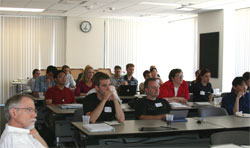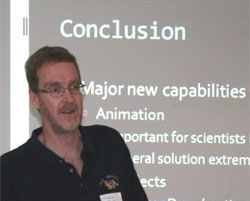Newsroom > Web Article
SURF-IT Mentors Share Research Projects, Challenges
 |
|
Students, staff, faculty and community
guests attended the presentation.
|
|
July 25, 2008, Irvine, Calif. -- The HIPerWall in the UCI Calit2 Visualization lab displays video, Google Earth images and complex data sets in super-high resolution. Now researchers are figuring out how to present 3D images and animation quickly and with the same degree of detail on the 200-megapixel tiled display wall.
Those and other challenges were the focus of two talks given at the second bi-weekly SURF-IT (Summer Undergraduate Research Fellowship in IT) symposium this week. This summer’s research fellows and about 30 other guests shared pizza and salad while listening to UCI professors Steve Jenks (electrical engineering and computer science) and Bill Tomlinson (informatics) discuss their research and the contributions their undergrad students are making.
|
|
|
|
Jenks (left) and Tomlinson
|
|
Jenks and SURF-IT fellows Alex Kindel and Ilya Sukharnikov are bringing animation and large 3D images to HIPerWall. “It’s a software problem but also an architectural problem,” Jenks said. “How do you get data to these displays and architect your system so it looks like one object on the screen?”
Static Decomposition
Because large scientific animations like global climate models and celestial simulations are too large for the HIPerWall Power Mac G5 computers to process, the team is utilizing a method called static decomposition. By splitting the original images into smaller pieces and decoding them, images can be processed into a series of smaller movies that are synchronized for playback. In essence, each of the 50 displays will play its own movie in sync with the other displays, forming one large animation.
Jenks said the approach, which uses open source applications including FFMPEG and Image Magic, is a preliminary one that will probably be replaced in the future, but should do the trick for now.
Large-scale 3D objects present their own challenges to HIPerWall, so the team is working on ways to coordinate drawing the objects across multiple displays. Their approach: program each of the 50 monitors to draw and display its own piece of the total picture, thereby avoiding bottlenecks. For starters, the team is modifying OGRE, an open-source 3D rendering application.
“We have to find a way of culling bits (of information) so that each machine only draws its own piece. That’s the hard part,” Jenks said. “We want to be able to take a generic open 3D format and throw it up on our screen without a lot of preprocessing.”
Success in both endeavors will make the room-sized display wall even more useful to researchers. “Together, these will mean major new capabilities for HIPerWall,” Jenks concluded.
Using IT to Benefit Society
Bill Tomlinson is mentoring two SURF-IT students – Andrew Zaldivar and Jordan Sinclair – and two National Science Foundation ‘Research Experiences for Undergraduates’ participants – Robert Simpson and Michael Riccobono. Tomlinson, who is interested in using information technology to impact social and environmental issues, is working on or overseeing projects in three categories: “green” IT, computational metaphor identification in political blogs and human-mediated networking.
Green IT projects include:
- “Trackulous ” –Tomlinson describes it as “graph paper meets Facebook ” –uses the Internet to help people track their environmental footprint or any other kind of data, while joining a community of like-minded online users;
- A Firefox environmental toolkit that seeks to provide people who are using Google maps with information about the relative environmental impacts of driving by car versus using public transit; and
- A forthcoming book on green IT that is in the proposal stage, and which the students will help research.
The metaphor identification project, doctoral candidate Eric Baumer’s research, involves building a set of computational tools to allow blog readers to become aware of and better understand how metaphors are used in political blogs.
Since blogs are taking a place among more established media as a go-to source of information for many people, they are becoming popular venues for political dialogue. Baumer, Tomlinson and Sinclair are interested in enabling the reading public to become more knowledgeable about the metaphors used in political blogs, and are creating online tools to support these practices.
The research involves analyzing large excerpts from Wikipedia with computational linguistics techniques that identify domain specific language patterns.
To indentify metaphors, those patterns are then mapped to similar patterns of language in political blogs. An online tool will allow readers to explore these metaphors and compare one blog to another. Tomlinson said the project should be complete by the end of the summer, allowing readers time to scrutinize their favorite blogs before the November election.
Reducing e-Waste
Lastly, Tomlinson described his human-mediated networking effort, which seeks to enable mobile devices to share sensors. He said there are approximately 2.7 billion cell phones in use around the world, and they are exchanged for new ones approximately every two years. “Even though cell phones are small, 2.7 billion of them create a … significant amount of e-waste with a big environmental impact,” he said.
He noted that each phone contains a variety of different components, including cameras, microphones and GPS, many of which are redundant. “If one phone has GPS and we’re all connected to it by Bluetooth, then we can all have a good idea of where we’re located,” he said. “We don’t all have to have GPS.”
The project’s goal is to enable mobile devices to share some of their components while maintaining their functionality so that fewer and fewer components have to be on every phone. “We’re trying to eliminate the need for every device to have every component,” said Tomlinson. “This could have a significant impact on the reduction of e-waste.”
The researchers are creating a simulation of the large-scale viability of this kind of system to learn what characteristics would enable them to be viable in different cities and other areas.
They are also working on an interactive demonstration in which desktops and cell phones can use this system to exchange information.



